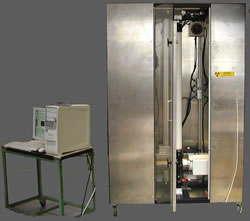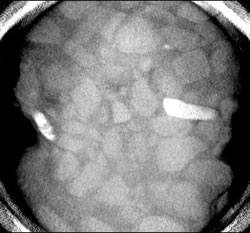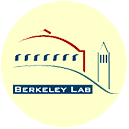|
BERKELEY, CA — Lawrence Berkeley National Laboratory
(Berkeley Lab) scientists have developed the world’s first x-ray
computed tomography (CT) scanner capable of examining entire core samples
at remote drilling sites. The portable device, which employs the same
high-resolution imaging technology used to diagnose diseases, could help
researchers determine how to best extract the vast quantities of natural
gas hidden under the world’s oceans and permafrost.
 |
|
 |
|
| Berkeley Lab’s portable scanner has sailed
the high seas and endured arctic cold, imaging more than 2000 feet
of core sample along the way. |
|
The scanner images the distribution of gas hydrates in core samples pulled
from deeply buried sediment. These hydrates are a latticework of water
and methane that form an ice-like solid under high pressures and temperatures
that hover just above freezing, conditions found in deep oceans and under
Arctic permafrost. Scientists estimate the methane trapped in this crystalline
mix may yield far more energy than the planet’s remaining reserves
of fossil fuel.
But they must first determine how to find and remove it. As part of this
investigational legwork, researchers drill into likely gas hydrate reserves
and extract core samples. Select samples are then shipped to laboratories
for analysis, and the resulting data is used to develop computer models
that predict how gas hydrates behave in sediments, which may help researchers
determine how to most efficiently locate and extract methane.
It’s a laborious process, however. Because gas hydrates rapidly
decompose when brought to the surface, the samples must be preserved under
high pressure and low temperatures, then shipped to labs hundreds of miles
away. This means the data required for these powerful numerical models
is harvested slowly, one carefully packaged-and-shipped core at a time.
Barry Freifeld, a mechanical engineer in Berkeley Lab’s Earth Sciences
Division, wondered if real-time, on-site analysis could expedite this
work. His optimism stemmed from earlier research in which he demonstrated
that a medical CT scanner can image a wave of methane hydrate dissociating
in a sand mixture.
“Nobody had ever done that before, and I asked why can’t
we also do it in the field,” Freifeld says.
Unfortunately, most CT scanners weigh more than 1000 kilograms, are bolted
to the floor, and are housed in lead-lined rooms. Portable they’re
not. On the other hand, their ability to splice hundreds of x-ray scans
into one cross-sectional image could enable researchers to map the distribution
of gas hydrates in core samples in unprecedented detail. If only such
power could be reduced in size and brought to the drill site.
Freifeld believed he knew how, and he got his break last spring after
learning the drill ship JOIDES Resolution was scheduled to probe
for gas hydrates off the Oregon coast. The vessel is operated by the Ocean
Drilling Program, an international partnership of scientists and research
institutions sponsored by the National Science Foundation and participating
countries. The group had previously used conventional x-ray imaging aboard
the ship to analyze core samples, but the images proved of marginal quality.
When Freifield suggested x-ray CT, essentially offering laboratory-quality
analysis on the high seas, the Ocean Drilling Program jumped at the chance.
His team received funding from the Department of Energy’s National
Energy Technology Laboratory, and in five weeks built a refrigerator-sized,
300-kilogram scanner. They trucked it to Oregon’s Coos Bay, loaded
it on a supply ship, sailed west overnight, and at daybreak hoisted it
aboard the JOIDES Resolution as it drilled along the Cascadia Ridge
in search of hydrates. Several hours later, the scanner analyzed its first
core sample, and churned through 1500 feet of core over the next several
weeks.
|
 |
 |
|
| A CT scan of a permafrost core reveals a mixture
of sandstone and quartz fluvial grains cemented in an ice-sand matrix.
|
|
“We can run core through the scanner almost as quickly as they
can pull it out,” says Freifeld “Now, researchers don’t
have to send kilometers of core to a lab to get the same information they
can obtain in the field. They’ll send data instead of rocks.”
Their success hinges on several innovations. Instead of a lead-lined
room to protect operators from radiation, they developed a three-piece
shield composed of a layer of lead sandwiched between two thin stainless
steel layers. This arrangement reduces the amount of lead usually required
to encapsulate x-ray imaging systems. And because x-rays passing through
the center of the core are more attenuated than those passing through
the edges, they designed a half-cylinder-shaped, aluminum compensator
that flattens the image intensity and ensures high-resolution imaging
throughout the core sample. In addition, special software reconstructs
a 3-D image of a scanned core, giving an operator the freedom to observe
the core’s interior from any angle and direction. And 3-D scans
can be taken at a rate of three minutes per foot of core length, yielding
resolutions between 50 and 200 microns.
“We’ve taken a million dollar medical instrument and transformed
it into a rugged, $150,000 piece of equipment,” Freifeld says.
This winter, the hearty scanner traveled above the Arctic Circle to the
permafrost stretches near Prudhoe Bay, Alaska. There, researchers are
conducting the first test on U.S. soil concerning how to extract methane
from gas hydrates. The scanner analyzed more than 500 feet of core sample,
enabling researchers to generate the most detailed log of permafrost cores
ever recorded. And the system worked in subzero temperatures.
“It ran fine, but the cold was hard on the technicians. We needed
a lot of tea and coffee,” Freifeld says.
 |
|
 |
|
| Although the scanner was developed last year, it
is already an old hand aboard the JOIDES Resolution (courtesy
of the Ocean Drilling Program). |
|
Luckily for Freifeld, the scanner is next headed to warmer climates.
It’s scheduled for another hitch aboard the JOIDES Resolution
as it sails from Bermuda to Newfoundland. The ship will drill along the
continental margin and study rifting, the tectonic process by which the
lithosphere thins and the seafloors spread. The scanner will allow scientists
to generate the most detailed lithostratigraphic record ever constructed
from oceanic cores.
“With this instrument, we can systematically investigate everything
recovered and generate a detailed electronic record,” Freifeld says.
“Its ability to conduct high-resolution imaging anywhere will have
a large impact on energy exploration, mining and fundamental research.”
In addition to Freifeld, Tim Kneafsey, Jacob Pruess, Paul Reiter, and
Liviu Tomutsa of Berkeley Lab’s Earth Sciences Division contributed
to the development of the scanner.
Berkeley Lab is a U.S. Department of Energy national laboratory located
in Berkeley, California. It conducts unclassified scientific research
and is managed by the University of California.
|

